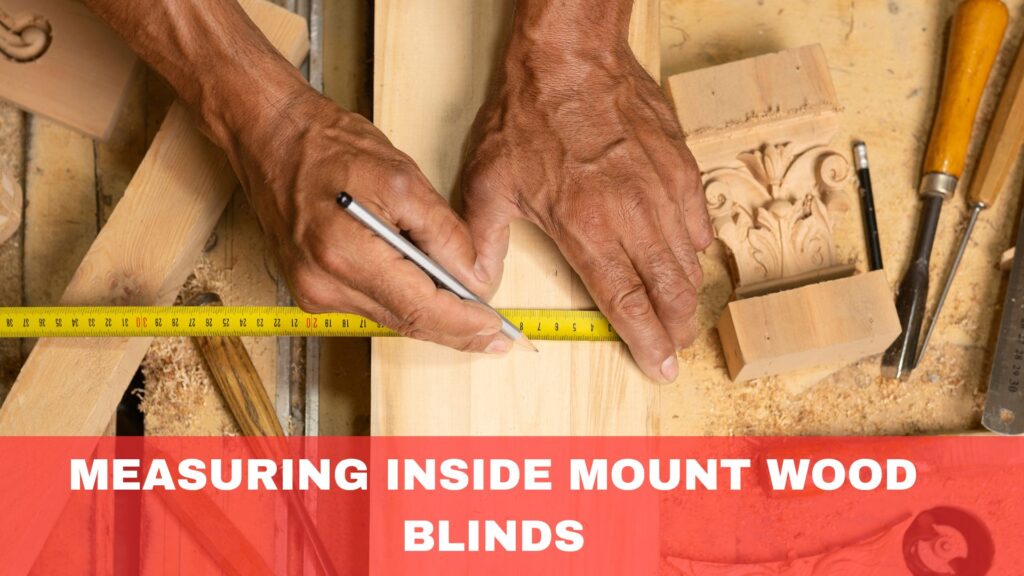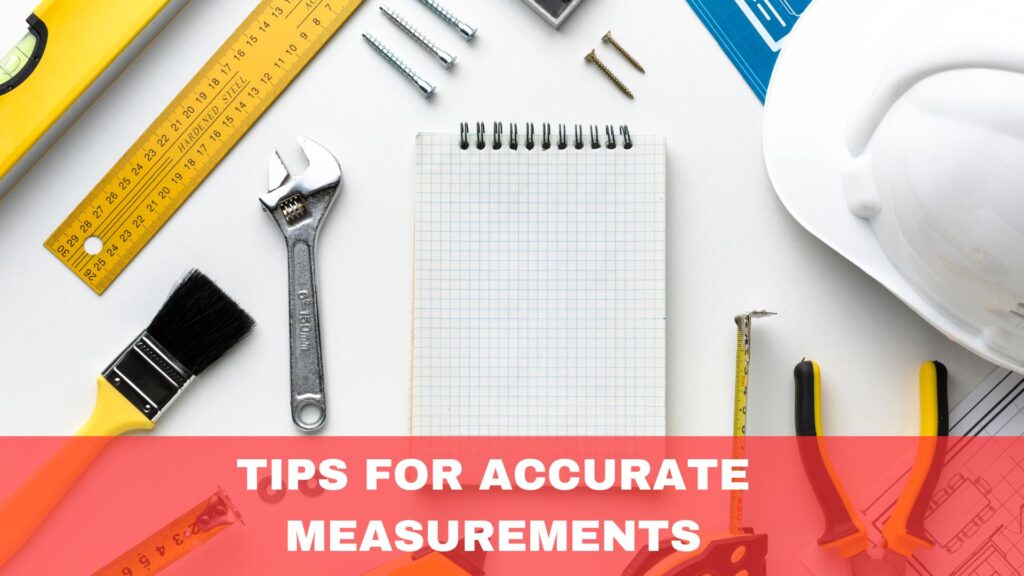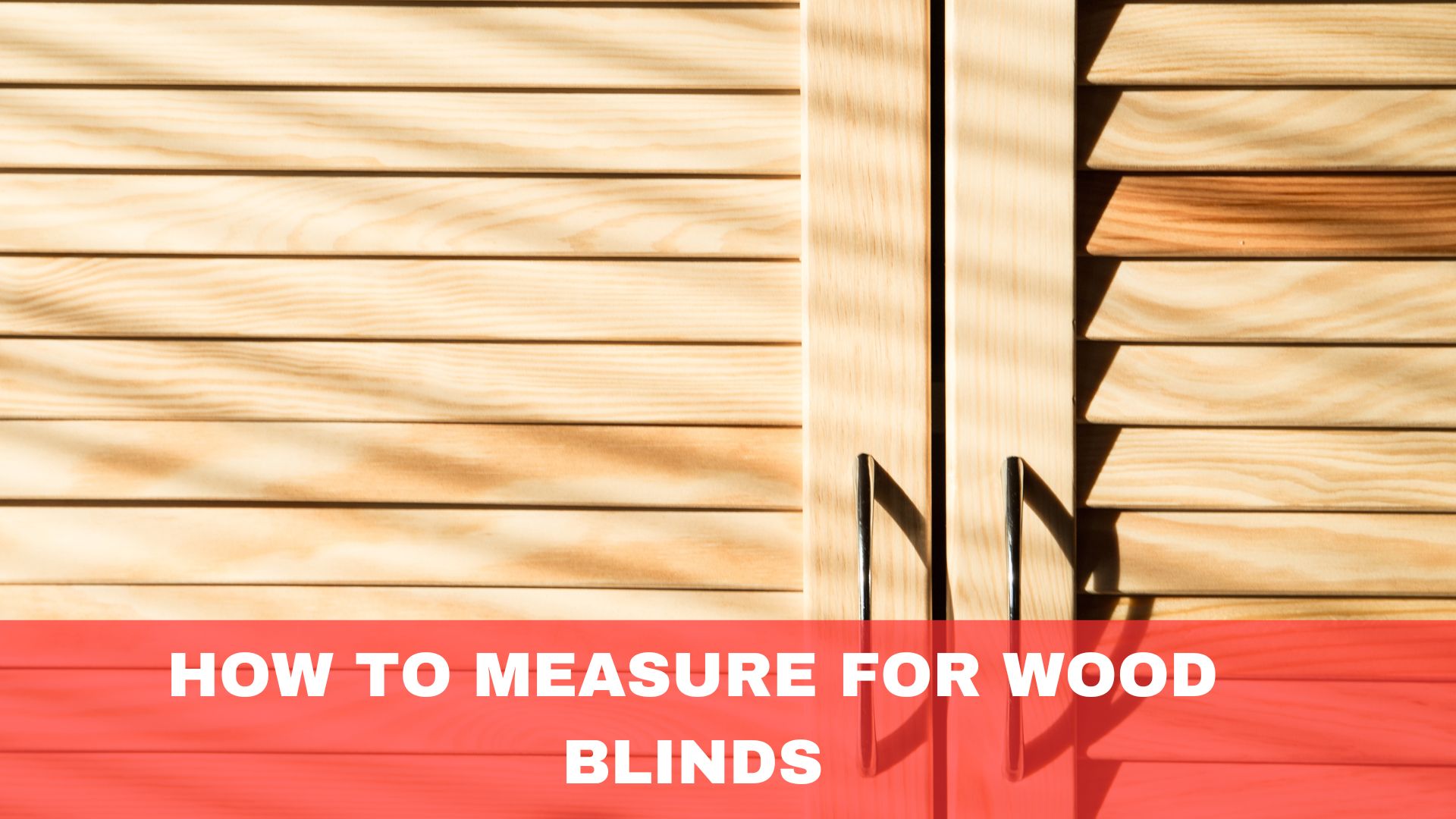Struggling to get the perfect fit for your wood blinds?
Incorrect measurements can lead to ill-fitting blinds that let in unwanted light, affect privacy, and spoil your decor.
Our comprehensive guide on measuring wood blinds will help you achieve precise measurements, ensuring a flawless fit and a stylish finish for your windows.
Tools You’ll Need

Having the right tools is crucial for accurately measuring your wood blinds. Here’s what you’ll need:
- Steel Tape Measure: This provides precise measurements essential for a perfect fit. Avoid cloth or plastic tape measures, which can stretch and give inaccurate readings.
- Pencil: Indispensable for marking measurements on the window frame or wall, allowing for easy adjustments and corrections without leaving permanent marks.
- Notepad: This tool is handy for recording your measurements immediately, reducing the risk of forgetting or misplacing numbers, especially if you are measuring multiple windows.
- Step Ladder: Essential for safely and accurately measuring high or difficult-to-reach windows.
- Level: Ensures your measurements are straight and true, critical for inside mount blinds.
- Measuring Template: This is helpful, especially for beginners, to ensure you measure the correct areas and avoid common mistakes.
- Masking Tape: Useful for holding the tape measure in place, particularly when measuring large windows or working alone, keeping your hands free and ensuring more accurate measurements.
- Calculator: This tool is handy for adding measurements, especially when dealing with fractions of an inch or centimetres, ensuring your final figures are correct.
Deciding Between Inside Mount and Outside Mount
Choosing between an inside mount and an outside mount is a crucial decision that impacts the look and functionality of your wood blinds.
Inside Mount

This style fits the window frame, offering a sleek appearance. It is ideal for windows with enough depth to accommodate the blind. Measure the width at the window’s top, middle, and bottom using the narrowest measurement.
For height, measure from the top of the window frame to the sill on the left, centre, and right, using the longest measurement. Inside mounts work best for unobstructed windows and provide a clean, built-in look.
Outside Mount

This style mounts on the wall or window trim, covering the entire window and potentially more. It is perfect for windows with shallow depths or obstructions like handles. Measure the width of the area you want to cover, adding extra width for better light control and privacy.
Measure the height from the top of the window trim to the desired length, ensuring complete coverage. Outside mounts are versatile and can make windows appear larger while hiding imperfections.
Measuring for Inside Mount Wood Blinds

Achieving a precise fit for inside-mount wood blinds requires careful measurement. Follow these steps for accuracy:
Step 1: Measure the Width
Measure the inside width of the window frame at three points: the top, middle, and bottom. Place your tape measure inside the window frame at the top and measure straight across to the opposite side. Write down this measurement.
Repeat the process in the middle of the window frame. This area is often overlooked but can vary slightly from the top and bottom. Measure at the bottom of the window frame from side to side. This area is crucial as it often has the most variance.
Use the narrowest measurement of the three. This ensures the blinds fit into the smallest part of the window frame, preventing any tight spots that could impede their functionality.
Step 2: Measure the Height
Measure the height from the top inside edge of the window frame to the bottom inside edge at the left, centre, and right points.
Measure from the top inside edge of the window frame to the bottom inside edge on the left side. Record this measurement.
Measure the height at the centre of the window frame, from the top inside edge to the bottom inside edge. This helps to capture any bowing or warping that might exist.
Measure the height on the right side of the window frame, again from top to bottom. This third measurement accounts for any height differences across the window’s width. Use the longest of these three measurements to ensure the blinds cover the entire window height, providing full coverage and light control.
Step 3: Measure the Depth
Measure the depth of the window frame to confirm that it can accommodate the blinds. Measure from the front edge to the back of the window frame. This depth is essential for ensuring the blinds fit correctly within the recess.
Check the product specifications for the minimum depth required for inside-mount blinds. Most blinds need a certain depth to fit flush and operate smoothly. Consider an outside mount instead if your window frame doesn’t meet this depth.
Measuring for Outside Mount Wood Blinds
Accuracy is critical to ensuring proper coverage and a polished look when measuring for outside mount wood blinds. Follow these steps for precise measurements:
Step 1: Measure the Width
To determine the width, measure the area you want the blinds to cover, not just the window. Start by measuring from one edge of the window frame to the other. Then, add 5 to 10 centimetres on each side to ensure the blinds fully cover the window and provide optimal light control and privacy. This additional width also helps block any light gaps around the edges.
Step 2: Measure the Height
For the height, measure from the top of the window frame or the desired starting point of the blinds to where you want the bottom to reach. Depending on your preference, add at least 10 centimetres above the window frame and extend down to the window sill or slightly beyond it. This ensures complete coverage and an aesthetically pleasing look.
Standard Measurement Mistakes to Avoid
Accurate measurements are essential for the perfect fit of your wood blinds. Here are common mistakes to avoid to ensure your blinds fit flawlessly:
- Not Measuring in Multiple Places: Measuring only at one point can lead to inaccurate results, as window frames often need to be more perfectly square. Always measure width at the top, middle, and bottom and height at the left, centre, and right. Using the narrowest width and most extended height ensures a precise fit.
- Rounding Measurements: Rounding up or down may seem convenient, but it can result in blinds that don’t fit properly. Always record exact measurements to the nearest millimetre to ensure a snug and accurate fit.
- Ignoring Obstructions: Overlooking window handles, cranks, or other obstructions can interfere with the blinds’ installation and operation. Note any protrusions and measure around them to ensure they don’t hinder the blinds.
- Incorrect Depth Measurement: Failing to measure the window depth accurately for inside-mount blinds can result in blinds that don’t fit within the frame. Check the product specifications for minimum depth requirements and ensure your window meets these.
- Not Double-Checking Measurements: Mistakes can happen, so always double-check your measurements before placing your order. A small error can lead to significant issues with the fit and functionality of your blinds.
- Assuming Windows Are Square: Many think that window frames are perfectly square, but slight variations are common. Always measure both diagonals of the window frame to check for squareness. If the diagonals differ significantly, you may need to adjust your measurements or consider an outside mount.
- Failing to Record Measurements Accurately: Inaccurate or illegible notes can lead to errors when ordering blinds. Write down measurements clearly and double-check them to ensure accuracy.
- Not Considering Window Treatments: If you have existing window treatments, ensure they won’t interfere with the new blinds. Measure the space available to confirm that both can coexist without issues.
Tips for Accurate Measurements

Accurate measurements are the foundation for perfectly fitting wood blinds. Here are essential tips to ensure you get it right:
- Use a Steel Tape Measure: Always use a steel tape measure for the most accurate readings. Avoid using cloth or plastic tape measures as they can stretch and provide inaccurate measurements.
- Measure at Multiple Points: Measure the width and height at three points (top, middle, and bottom for width; left, centre, and suitable for height). Use the narrowest width and the most extended height to ensure the blinds fit correctly within the frame.
- Keep the Tape Measure Straight: Ensure the tape is straight and not angled. A crooked tape can result in inaccurate measurements, leading to ill-fitting blinds.
- Record Exact Measurements: Write down your measurements to the nearest millimetre. Avoid rounding up or down, as this can cause the blinds to be too tight or loose.
- Double-Check Your Measurements: Mistakes happen, so it’s crucial to double-check your measurements before placing your order. Verify each measurement to avoid errors.
- Consider Obstructions: Be aware of any window handles, cranks, or other obstructions that may affect the fit of the blinds. Measure around these to ensure they don’t interfere with the installation.
- Measure Depth for Inside Mounts: For inside mount blinds, check the window depth to ensure it meets the minimum depth requirement specified by the manufacturer.
- Keep Notes Organized: Keep clear and organized notes of your measurements, ensuring they are easy to reference when ordering.
What to Do with Your Measurements
Once you’ve taken precise measurements for your wood blinds, the next step is to use them correctly to ensure a perfect fit. Here’s what to do with your measurements:
- Double-Check Your Measurements: Before proceeding, double-check all your measurements for accuracy. Verify that you’ve recorded the narrowest width and the most extended height for inside mounts and added the necessary extra for outside mounts.
- Consult the Manufacturer’s Guidelines: Different manufacturers may have specific blind order requirements. Refer to their guidelines to ensure your measurements meet their criteria. Check for any adjustments you might need to make based on their recommendations.
- Input Accurate Measurements When Ordering: Ensure you input the measurements you’ve taken when placing your order. Most online blind ordering systems have fields for width and height. Enter your figures carefully to avoid any errors resulting in ill-fitting blinds.
- Specify Mount Type: Indicate whether you want an inside or outside mount. This information is crucial as it affects the final size of the blinds that will be manufactured.
- Keep a Copy of Your Measurements: Save a copy of your measurements for future reference. This is helpful in case you need to reorder or make adjustments.
- Contact Customer Service if Needed: If you have any doubts or questions about your measurements, contact the blinds manufacturer’s customer service team. They can assist and confirm that your measurements are correct.
Conclusion
Accurate measurements are crucial for perfectly fitting wood blinds. By following this comprehensive guide, you can ensure a flawless fit and stunning look for your windows. Ready to transform your space? Measure with precision and explore our high-quality wood blinds at Into Blinds Melbourne today!



